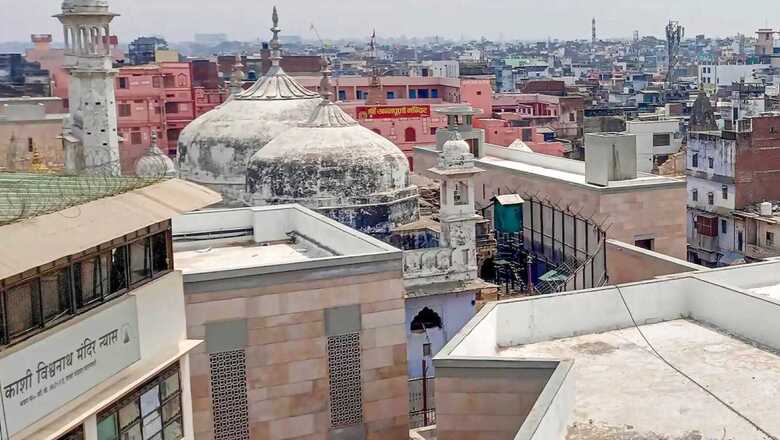
views
Varanasi, which is just 200 km from Ayodhya, has now taken the centre stage in national news as the controversy involving the Gyanvapi shrine complex is stoking the religious sentiments of both the Hindu and Muslim communities in India. The disputed Gyanvapi complex, claimed to have been built in 1669 by Mughal invader Aurangzeb, is located near the Kashi Vishwanath temple. It is one of the many religious places in India where places of worship of two different religions are located close to each other, or in some cases one is built after the demolition of another, like the Ram Janmabhoomi-Babri Masjid in Ayodhya.
The Entry of Judiciary in the Controversy
With the matter now at the doorstep of the courts, history and historical facts count as evidence with respect to the findings in the premises of the disputed area of Gyanvapi.
Given the “complexity of the issues involved in the suit and their sensitivity”, the Supreme Court ordered the transfer of the pending proceedings from Civil Judge, Senior Division, Varanasi to District Judge, Varanasi for “trial and all interlocutory and ancillary proceedings.”
Therefore, the District Court at Varanasi is now hearing the petition by five Hindu women who have requested access to the Gyanvapi mosque complex – located next to the prominent Kashi Vishwanath temple – to worship idols along its outer walls.
The Places of Worship Act, 1991
According to Section 3 of the Places of Worship (Special Provisions) Act, 1991, there exists a restriction on the convertibility of a religious place from one faith to another. Due to its relevance in the said matter, the constitutional validity of this section, and thereby the entire Act is also in question.
The most recent update in this dispute is the finding of a “Shiva Linga”-like structure inside the mosque. Two reports have been submitted to the Varanasi court following the videography survey ordered by the district court; debris from old temples and a few Hindu religious motifs like bells, kalash, flowers, etc. have reportedly been found inside the Gyanvapi premises. As a procedural step, the district court invited objections to the report from both sides.
The Muslim camp, i.e, the Committee of Management Anjuman Intezamia Masjid, approached the Allahabad High Court to order a stay on the district court proceedings, citing provisions of the Places of Worship Act. As the Allahabad High Court refused to interfere, they rushed to the Supreme Court. A three-judge bench of the Supreme Court ordered that the area where the “Shiva Linga”-like structure has been found should be secured and sealed, but not forbidding or impeding in any way the entry of persons of Islamic faith to perform namaz and other religious observances.
The Supreme Court bench also directed that the application filed by the mosque committee, challenging the maintainability of the suit by the five Hindu women petitioners seeking to enforce the right to worship on the outer walls of the Gyanvapi complex near the Kashi-Vishweshwar temple, be decided on priority by the District Judge upon the transfer of the suit. The outer walls, as the Hindu petitioners have contented, resemble the idols of Hindu gods and goddesses.
The Claim and the Counter Claim
The Hindu side has insisted that the Gyanvapi complex is a Hindu temple and not a mosque. Further, Mughal Emperor Aurangzeb had not passed any order to create a waqf over the land in question or for handing over land to any Muslim entity or persons of the Muslim faith.
On the other hand, the Muslim side has argued relying entirely on the law: The Places of Worship Act, 1991. The provision under Section 4 of the Act bars filing of any suit or initiating any other legal proceeding for the conversion of the religious character of any place of worship, as it existed on August 15, 1947.
Section 5 of The Places of Worship Act, 1991 makes an exception for Ram Janmabhoomi–Babri Masjid.
Ancient Monuments and the Law
Hindu religious scholars have not only challenged the validity of the Places of Worship Act, 1991 but also argued that the Act does not apply to the current controversy around Gyanvapi, contending that the site falls under the applicability of The Ancient Monuments and Archaeological Sites and Remains Act, 1958.
The argument is not totally baseless as the remains of Hindu temples and idols are apparently visible at the controversial site. If this is to be considered true, it will be interesting to see how the question related to the applicability of the Places of Worship Act is dealt with by both the parties and adjudicated by the court. It is not unwise to expect more revelations in the coming days which may take the controversy in any direction.
Advocate Satya Muley is the founder of the legal firm Satya Muley & Co based out of Pune, Maharashtra and a practising lawyer in Bombay High Court and the Supreme Court. The views expressed in this article are those of the author and do not represent the stand of this publication.
Read all the Latest Opinions here
















Comments
0 comment